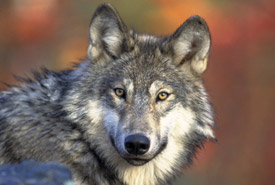Common species 101

Grey wolf (Photo by Gary Kramer, courtesy of USFWS)
We often hear a lot about rare, endangered or disappearing species — species that are in need of swift action to save them. There is no doubt that they are important to talk about. How else do we raise awareness about the last populations of plants and animals that we could lose forever? Knowing what species are in trouble helps us to identify habitats in the greatest need of protection. In many cases it is this urgency that compels us to work quickly to save them.
But what about all the other species? The common species: who is speaking for them? After all, some rare species, like American chestnut, woodland caribou and lake sturgeon, are also just once common species fallen into hard times.
Common species are important in conservation — because we want them to remain common. The Nature Conservancy of Canada (NCC) works to identify, protect and manage the best examples of all ecosystems so that all biodiversity — the full range of species and communities, rare or common — is conserved. By protecting land for all species, we help to ensure that common ones won't also follow the way of the dodo.
Once common, now gone
Wild lupine once abounded across the great prairie and savannah habitats of the Rice Lake Plains. In her book, Canadian Crusoes, Catharine Parr Traill, a pioneer of the Rice Lake Plains era in the 1830s, recounts:
"The azure lupine claimed its place, shedding almost a heavenly tint upon the earth."

Wild lupine (Photo by Bill Crowley)
With those wild lupines were Karner blue butterflies, whose larvae use the native wildflower as its primary food source. Now, due to the loss of enormous areas of oak savannah habitat and with it wild lupine, the Karner blue is extirpated (locally extinct) from Ontario and the rest of Canada. Sometimes we don't understand the connections between species until it's too late.
Trophic cascades
Common species often play important roles in helping to balance ecosystems. Whether controlling systems from the top down as do predators like wolves, or from the bottom up as do the "lowly" zooplankton in the Great Lakes, the loss of once-common species can have far-reaching impacts on an ecosystem. Anyone who has seen the damage that deer can wreak through over-browsing knows first-hand what the loss of a top predator looks like. Top predators are incredibly important in regulating all levels within an ecosystem.
Take, for example, the return of wolves to Yellowstone National Park. Since the deliberate eradication of wolves from Yellowstone in the early 1900s, elk numbers dramatically increased, flourishing under predator-free conditions. The elk began to heavily browse the willows and cottonwoods that grow in areas along rivers and streams. Soon after, trout numbers began declining. The protective vegetation, now removed, caused the once clear rivers to turn murky and to warm.
With the reintroduction of wolves beginning in 1995, elk numbers were reduced, riparian vegetation returned, and the cooling and clearing of the rivers allowed the trout to return. Stories like this abound throughout nature, many of which we have not yet even begun to understand, making it all the more important to protect all native species, rare or not. In the famous words of ecologist Aldo Leopold:
"To keep every cog and wheel is the first precaution of intelligent tinkering."
Keystone species
Keystone species are species that have a great influence on shaping their ecosystems. These species may not be the most abundant species in the ecosystem, but their presence has a big impact on the overall diversity and function of their community.

A beaver carries a willow branch across the water. (Photo by Steve Hillebrand, courtesy of USFWS)
The American beaver is a great example of a keystone species. The beaver, through its own instincts of survival, changes its habitat to make access to trees easier and to avoid predators. By damming waterways, beavers create a whole new habitat and can influence an entire watershed. The flooding creates open ponds. Aquatic plants expand into new areas and flooded trees die, providing new habitat for woodpeckers, herons and osprey. Some species of frogs, ducks, fish and insects all benefit from the new habitat, while others may be forced to move on.
Whatever the impact, it's clear that a single beaver's actions have intricate and cascading effects on an ecosystem. The protection of species like American beaver is therefore critical to protecting entire ecosystems, many of which also support rare species.
Indicator species
Although many frog species are common, they are essential bioindicators — species that are particularly sensitive to the quality of their habitat and whose changes in population can point to problems in the environment.
Indicator species are often impacted by a combination of effects like pollution and UV radiation.
Frogs can breathe through their skin; behaviour made possible by the skin's semi-permeability. It is this semi-permeable skin that also makes them great bioindicators. Oxygen from the water is absorbed into the bloodstream as water permeates the skin, but so too are pollutants. This can lead to population declines or, as has been observed, physical mutations like fifth legs.

Northern leopard frog on the banks of the Lower Maitland River Valley, Ontario (Photo by NCC)
Protecting and monitoring frog populations provides insight into the health of the ecosystems they inhabit. This helps inform management planning by bringing environmental problems like pollution to our attention, allowing us to mitigate the problems and protect all of the species affected.
How does it all fit together?
We could once claim ignorance of our long-term impacts on the land, but we now know much more about the interdependence of species and ecosystems and the complex web of all living things, including humans. Now we know how to help prevent the extirpation of the next Karner blue. And so, when we protect habitat for common species like American beaver, this part of our work has important, long-term benefits for all the common species like beavers that find a home in protected areas.
The story of the Karner blue is compelling. But it is also very sad. The fewer stories like these that we have to tell over the years, the better we're doing. And that's how we'll know that conservation, whether it be local, national or global in scope, is really working the way that conservationists dream it should.

The extirpated karner blue butterfly (Photo by J. and K. Hollingsworth, courtesy of USFWS)
Sources
Howse, Adrienne. 2001. ActionBioscience.org: Where Have All the Frogs Gone? UV Radiation and Amphibian Declines.
Save the Frogs: Why Frogs Are Important.
Sobczak, Charles. 2003. Gulfshore Life: Three Cheers for Our Predators.
Toronto Zoo, Adopt-A-Pond. Wetland Curriculum Resource Unit 6: Keystone Species - The Beaver.




